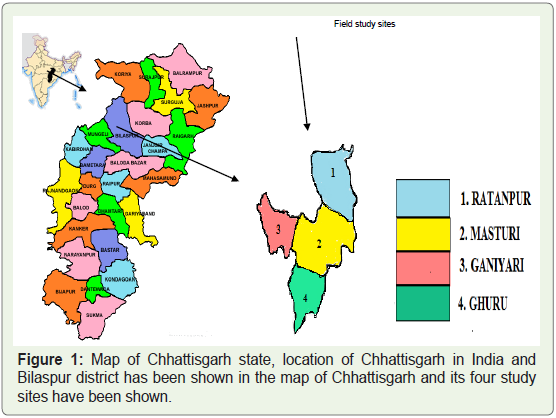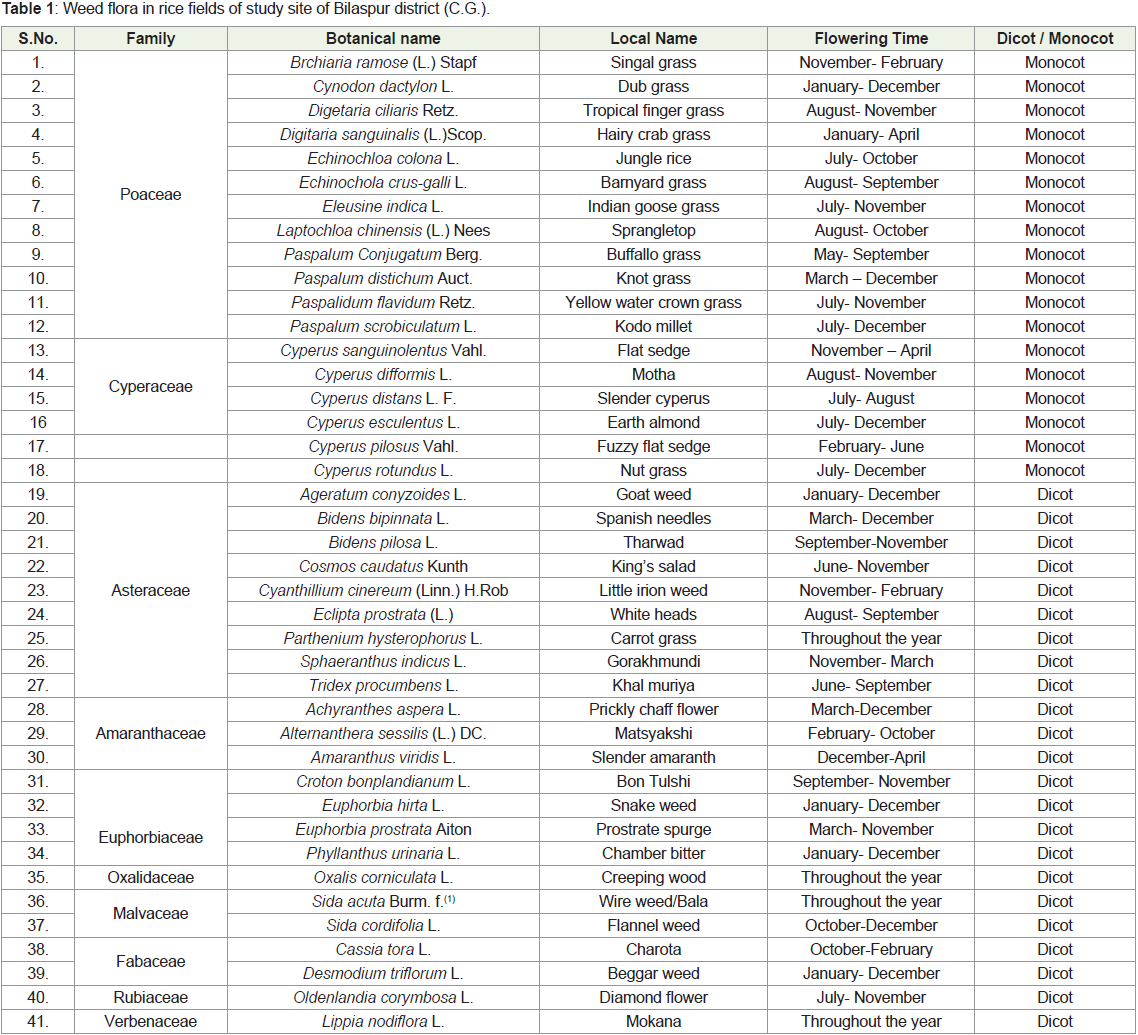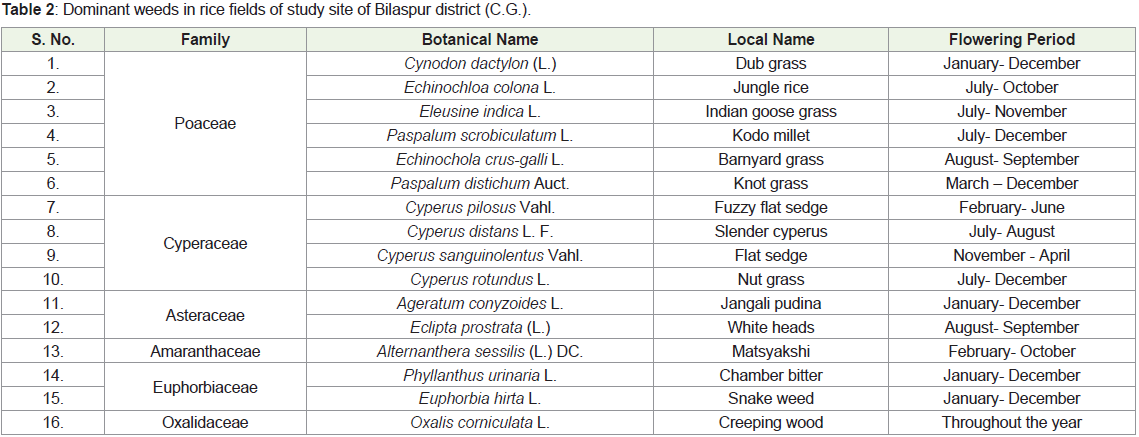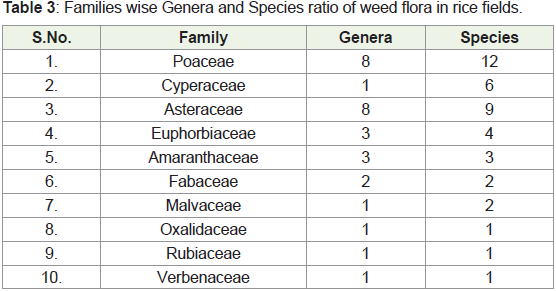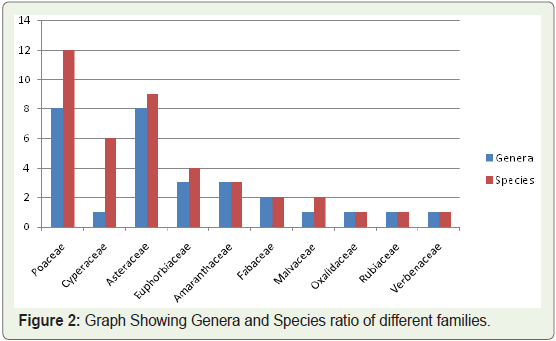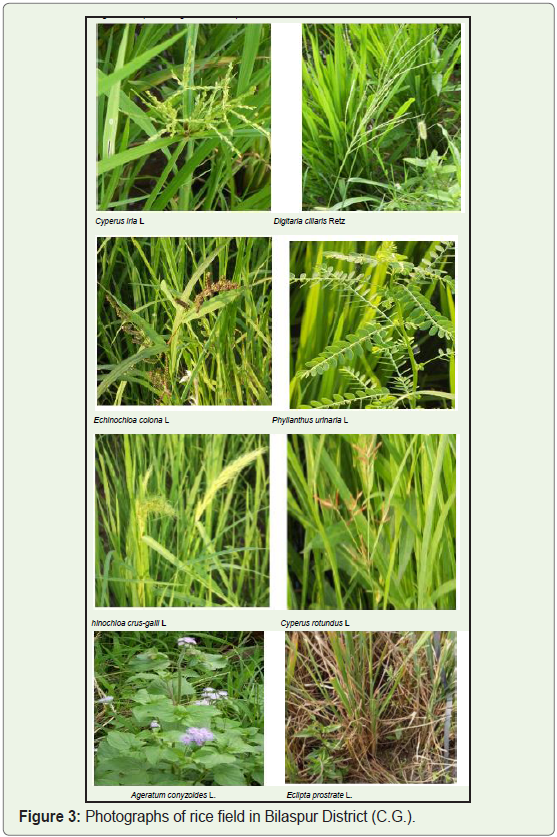Research Article
Survey of Weed Flora in Rice Fields of Bilaspur District, Chattisgarh
Soni MY1* and Sharma RP2
1Atal Bihari Vajpayee Vishwavidyalaya, Bilaspur, Chhatisgarh, India
2Department of Botany, Government Agrasen College, Bilha, Bilaspur, Chhattisgarh, India
*Corresponding author: Soni MY, Atal Bihari Vajpayee Vishwavidyalaya, Bilaspur, Chhatisgarh, India; E-mail:
yaminisoni89@gmail.com
Copyright: © Soni MY, et al. 2022. This is an open access article distributed under the Creative Commons Attribution License,
which permits unrestricted use, distribution, and reproduction in any medium, provided the original work is properly cited.
Article Information: Submission: 25/04/2022; Accepted: 03/06/2022; Published: 07/06/2022
Abstract
Rice is the staple food of more than half of the population of the world, is an important target to provide food security and livelihoods for millions. Weeds
grow and dispersion patterns in rice fields are dynamic in nature. The survey of weed flora was conduct in Bilaspur district region of Chhattisgarh state to
identify problem of weed species in the rice field. The survey has been carried out of four selected site in rice field. During the study and survey of weeds
plant in rice field have been done in the month of August to September 2021. Climatic conditions are generally wet and humid type in this region and rainfall is
average. The result of this survey has obtained 41 weed species belonging to 29 Genera and 10 families. Dicot /monocot ratio of weeds is 23/18 and Genera
/ Species ratio are 29/41. Dominating Weed families in the rice fields of study site in Bilaspur district are Poaceae, Cyperaceae, Asteraceae, Euphorbiaceae,
Amaranthaceae, Oxalidaceae. The highest number of weed species in rice field of study sites is form poaceae family belonging to 8 genera and 12 species
and less weed species is from Oxalidaceae, Rubiaceae and Verbenaceae families belonging to 1 genera and 1 species. The study was based on survey of
weed species in rice field of Bilaspur district (C.G.).
Keywords
Rice weeds; Bilaspur district; Dominating species
Introduction
Rice (Oryza sativa L.) is a member of poaceae family and is
a staple food of world population. Rice is extensively cultivated all
over the country. In Chhattisgarh rice is the most important and
extensively grown food crop and rice is an important target to
provide food security and livelihoods for millions. Paddy is a source
of income for number of industrial products like rice starch, rice bran
oil, flaked rice, noodles, puffed rice, rice straw product and rice husk
etc. Being staple food it plays a great role in the economy of India
hence occupies a central position in agricultural policy making [1-3]. India is the second big largest producer of rice after china. Rice
is the primary source of income and employment of many farmers.
Paddy is the identity of Chhattisgarh due to which it is called rice
bowl of Chhattisgarh. The reduction in paddy yield due to weed
composition ranges from 9-51%. Uncontrolled growth of weeds in
paddy reduced the grain yield by 75.8, 70.6 and 62.6% in dry seeded rice, wet seeded rice and transplanted rice, respectively. In weed
management program, a tough survey is necessary to address the
current weed problems in the rice field and survey information is very
much important in building target oriented research programs [2].
Weeds are unwanted plants of any plant community. They
interfere with the main crop by utilization of land and water
resources, and reduce quantity and quality of rice production. Weed
is an aggressive pest for rice causing serious yield reduction in rice
production worldwide. The weeds that grow along with paddy crop
results of output of agricultural are very low. They are the major
barriers to rice production because of their ability to compete for co2,
space, water, moisture, sunlight, and nutrients. Weeds take all the
nutrient of the soil from where they grow and fertility, nutrient of
soil gets reduced. Among the cereal crops, it serves as the principal
source of nourishment for over- half of the global population [4]. Weeds are suppressed to rice production & their marketing rate also
affected by weeds. Weed succession and distribution pattern in rice
fields are dynamic in nature. The composition of the weeds flora may
differ depending on location and atmosphere [1].
Materials and Methods
Study area:
Bilaspur district is located in the northern region of Chhattisgarh
state. Bilaspur is located 260 meters above sea level (Figure 1). The
geographical location of the study site is 25°.5’ North latitude and
82°.12’ East longitude and it is a big rice cultivation area [5-9]. Survey
was conducted in four different sites of the Bilaspur district. Site’s are
- Masturi, Ghuru, Ratanpur, and Ganiyari. These sites are located in
approximately 25 km. distance from each other. Climatic conditions are generally wet and humid type. The rainfall of month of august and
September are 5.8 and 8.0 mm respectively and the minimum and
maximum temperature of the district are 23.40c and 31.50c. in month
of August and 23.2 and 31.5 in month of September. (Source: Climate
department, Barrister Thakur Chhedilal college of Agriculture &
Research Station Bilaspur Chhattisgarh. The climate is ideal for
agriculture development, particularly for rice [10,11].Methodology
General survey was done in rice field in the month of august to
September 2021 by quadrate method. The size of quadrate is 50×50
meter. Obtained weed plants were identified with the help of available
literature and standard flora (5) .Their Botanical name, family, local
name, flowering period are identified.
Result & Discussion
Table 1 indicate during the study and survey of weeds plant of rice
field in Bilaspur district more than 41 weed species obtained belonging
to 10 families and 29 genera. Dicot/ Monocot ratio of weeds species are
23/18 and genera species ratio are 29/41. According to Table 2 dominant
weeds families are Poaceae , Cyperaceae, Asteraceae, Amaranthaceae,
Euphorbiaceae and Oxalidaceae with genus Echinochloa, Cynodon, Paspalum, Eleusine, Cyperus, Ageratum, Eclipta, Alternanthera,
Phylanthus, Euphorbia and Oxalis and its species are colona, crusgalli,
dactylon, scrobiculatum, distichum, indica, rotundus, pilosus,
distans, sanguinolentus, conyzoides, prostrata, sessilis, urinaria, hirta,
corniculata (Figure 2 & 3). Table 3 indicate families wise genera and
species ratio of weed flora in rice fields of study area which is based
on Table 1. In this table monocot Poaceae family is most dominating
families belonging to 8 genera and 12 species and in dicot Asteraceae
is most dominating families belonging to 8 genera and 9 species and
less weeds species is from Oxalidaceae, Rubiaceae and Verbenaceae
families belonging to 1 genera and 1 species which is shown in the
graph. Similar result obtained by many researches such as Sharma
R.P. and Dubey V. (2009) in Bilaspur district (Chhattisgarh), Sinha
M.K. (2017) in Koria district (Chhattisgarh), Karim S.M.R., (2004)
in Malaysia, L.R. Dangwal (2012) in Rajouri district (J&K) [12-15].
The report of all these is a discussion on the weed problem in the
paddy field. Weeds are a persistent problem in agriculture production
system and increased production cost, resulting in high economic
losses.

